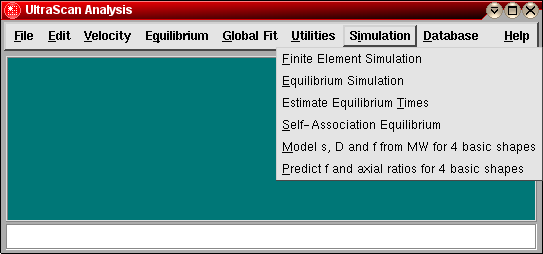

|
Manual |
Simulation:
These functions provide access to various simulation modules of UltraScan.
This document is part of the UltraScan Software Documentation
distribution. The latest version of this document can always be found at:
Last modified on April 12, 2003.

This function allows you to simulate sedimentation velocity and approach to equilibrium
experiments. You can define all parameters of the model and watch a movie of the
simulated data. For details, check here.
This function allows you to simulate sedimentation equilibrium data for
noninteracting and self-association models. You can define all parameters
of the model and display the simulated data as well as a concentration
histogram. For details, check here.
This function allows you to estimate the length of time required to
reach equilibrium. Multiple speeds can be simulated successively and
preset or custom rotor positions can be used. More information about
this function can be found here.
This function allows you to display relative concentrations of the
self-associating species with respect to the total concentration. You
can enter association constants to simulate an associating system. More
information can be found here.
This function allows you to simulate hydrodynamic parameters for 4
basic shapes (sphere, prolate and oblate ellipsoid, and long rod)
from the axial ration, the molecular weight, partial specific volume,
density and viscosity. More information on this function can be found
here.
Given two of the three parameters (diffusion coefficient, sedimentation
coefficient, or molecular weight) this function will predict the value
of the third and calculate the axial ratio for the oblate and prolate
ellipsoid models, and if applicable, for the long rod model. It will also
calculate the frictional properties and the volume of the particle.
More information can be found here.
www contact: Borries Demeler
Copyright © notice.